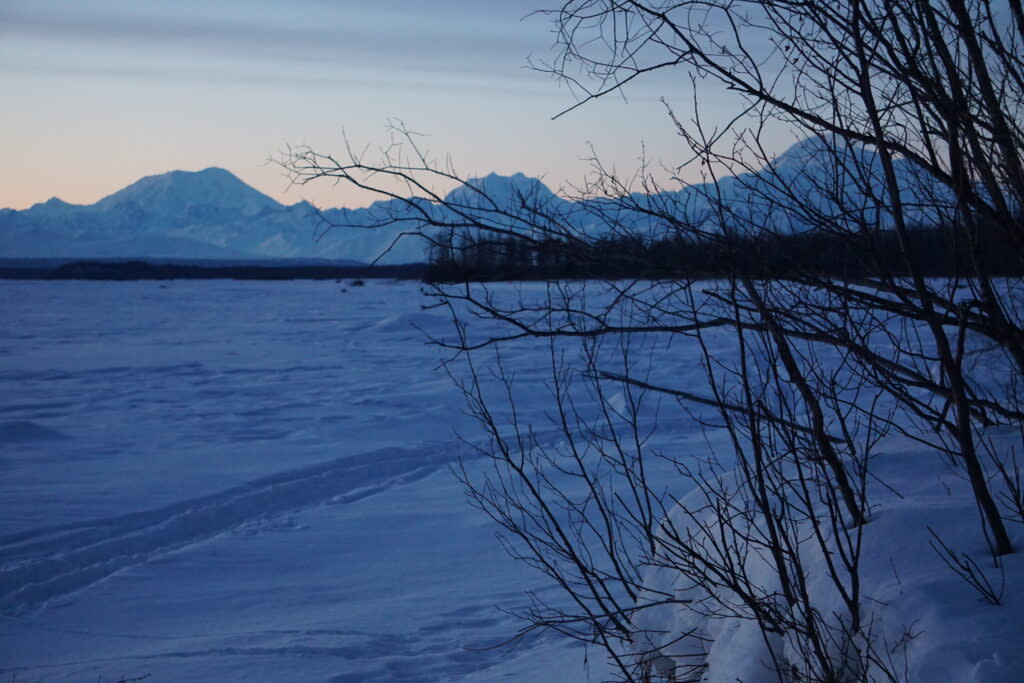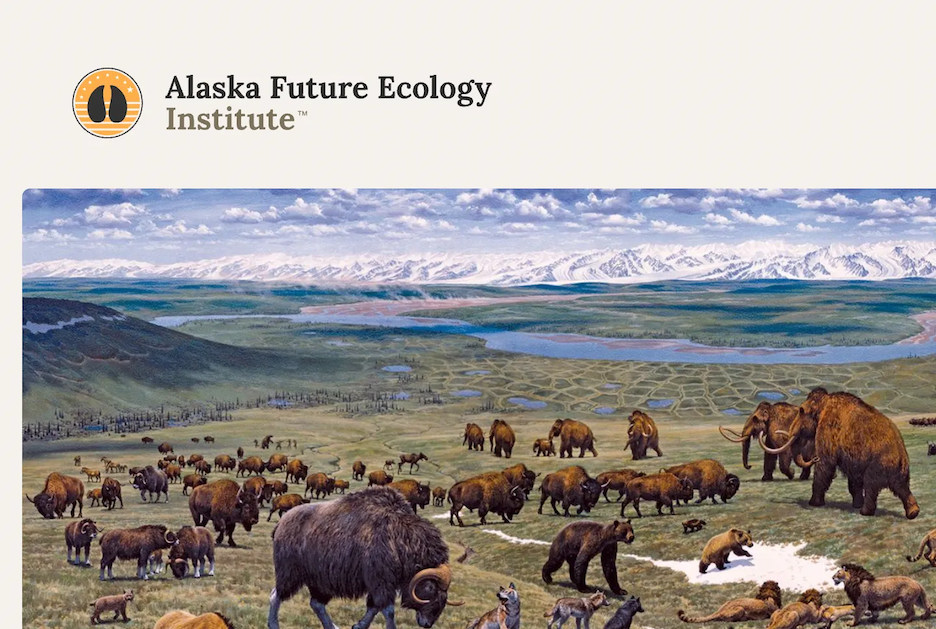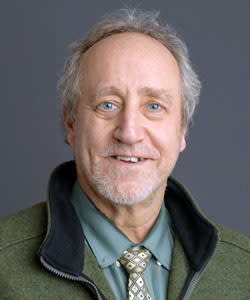Something woolly is afoot in Alaska

- Oops!Something went wrong.Please try again later.
From right to left, Denali, Mount Hunter and Mount Foraker are seen from the frozen Talkeetna River on the evening of March 9, 2024. (Photo by Yereth Rosen/Alaska Beacon)From right to left, Denali, Mount Hunter and Mount Foraker are seen from the frozen Talkeetna River on the evening of March 9, 2024. (Photo by Yereth Rosen/Alaska Beacon)
For a journalist, it’s hard to imagine an entry on a public official’s calendar more enticing than four hours of woolly mammoth.
OK, it’s not actually that hard — entries like “bribe acceptance” and “V. Putin secret meeting” would also get me pretty excited. Nonetheless, it is an understatement to say that I was prettttttty curious about this item on the calendar of Doug Vincent-Lang — the guy who, as Alaska’s fish and game commissioner, would presumably retain authority and jurisdiction over anything related to that most charismatic of megafauna.

I was already vaguely aware of some Alaska-adjacent mammoth-related discussions happening in the realm of biotech. A company trying to bring them back from the dead, maybe? Russian scientists who envisioned a resurrected mammoth on a stretch of tundra somewhere in Siberia?
There, sandwiched between an Anchorage-Juneau flight and meetings with lawmakers and seafood processors, was a four-hour block of mammoth! Was something woolly afoot? I had to know. So, I sent a public records request to Vincent-Lang’s special project assistant, Kari Winkel — a mammoth fishing expedition.

I also then made my first bad mammoth joke. Sorry.

I sent the state a check for $70.06 to pay for search fees. Then, I waited. For a month.
Until April 29, when my regular search for newly-registered lobbying contracts at the Alaska Capitol turned up a “pro bono” agreement between lobbyist Reid Harris and an outfit called the Alaska Future Ecology Institute.
I googled “Alaska Future Ecology Institute.” This is what popped up.

Something woolly was definitely afoot.
So, I emailed Harris, with the subject line “woolly mammoths,” asking if his clients would talk to me. His response indicated that we would be taking a slight detour from this story’s original subject matter.
“AFEI isn’t the group planning to reintroduce woolly mammoths,” he said. “AFEI is applying for a 7,000-acre test plot on Department of Natural Resources land to reintroduce bison, musk oxen, and other large herbivores (non-extinct ones) to study their ability to prevent permafrost thaw and therefore sequester carbon.”
Oh. My mistake! (An entirely reasonable mistake, I would argue, given what appear to be the happily frolicking mammoths on AFEI’s website.)
OK, not zombie mammoths. But, as I will explain, there was still something of a mammoth nexus here. And talking to the Alaska Future Ecology Institute still sounded like a great way to procrastinate.
Which is how, last week, I found myself on the phone with Luke Griswold-Tergis, who, for a guy in charge of a future ecology institute, has a predictably colorful biography: “back-to-the-lander hippie” parents; a degree in cultural anthropology; fishing and sailboat-hitchhiking around Southeast Alaska; and sailboat-dwelling in the harbor in Haines, a community notorious for, among other things, having a higher than average density of back-to-the-lander hippie weirdo types.
As it turns out, Griswold-Tergis is an expert on this herbivore-permafrost-carbon stuff because his biography also involves 10 years working on a documentary film about Pleistocene Park, in Siberia.
There is already a LOT of stuff that you can find on the internet about Pleistocene Park, so I am going to give a very brief summary, courtesy of Griswold-Tergis, who once described the men behind the project as “crazy Russian gonzo-scientist cowboys.”
The lead gonzo-scientist-cowboy is Sergey Zimov, a bearded, beret-sporting ecologist who set up his research station in remote eastern Siberia. Zimov’s son, Nikita, is also involved.
The modest idea for the park, 3,400 miles northeast of Moscow, is helping to save the planet from global warming.
Here’s the theory.
There’s an enormous amount of carbon embedded in permafrost underneath the Arctic tundra. If the permafrost thaws, that carbon will float up into the atmosphere and amplify climate change. But: Maybe not, if we put an epic number of large herbivores on the tundra and restore an ancient grassy ecosystem.
Typically, snowfall insulates the tundra from winter’s coldest temperatures. Add herbivores; they trample around and compress the snow, allowing the ground to cool more deeply. They could also transform mossy tundra into grassland, which reflects more sunlight and, hence, could limit permafrost thaw in summer.
The Zimovs have populated their eight-square-mile plot with horses, musk oxen, bison, moose, even a two-humped native of the central Asian steppe, the Bactrian camel. A 2020 paper they published in a peer-reviewed journal suggested the idea was working: Soil temperatures measured inside the park were, on average over the year, two degrees Celsius cooler than those measured outside.
Unfortunately, the Russian invasion of Ukraine has quashed elements of the Zimovs’ cross-border partnerships, according to Griswold-Tergis.
This is where Alaska comes in. Specifically, 7,000 acres of Alaska — state land, in striking distance of Denali National Park and Preserve. Griswold-Tergis wants to lease the property, fill it with herbivores and rigorously observe what happens in an attempt to further prove out the Zimovs’ theories. Tourists could spill over from Denali and help fund operations with entry fees.
Griswold-Tergis estimates that he needs perhaps $30 million to pull off his vision. So far, he has raised “a hundred thousand bucks, maybe.” His novel proposed use of state land, he added, may also require legislative approval — thus the lobbyist.
All of which means it’s probably going to be a while before you can view reindeer, bison, elk, moose and musk oxen on Griswold-Tergis’ plot.
And mammoths? “We’re officially mammoth-agnostic,” he said. “No one’s offering me a mammoth.”
Not yet. But the idea isn’t quite as far-fetched as it sounds.
A day before I interviewed Griswold-Tergis, the Department of Fish and Game responded to my public records request.
Among the emails in the department commissioner’s inbox was one from an executive at a startup company that’s reportedly valued at more than $1 billion. (This is my way of telling you it is unlikely this guy was high on drugs when he crafted this note, even if it might seem that way.)

I should drop the mic and walk away from this story right here, because I probably will never achieve more journalistic greatness than digging up an email in which a tech executive pitches the state’s top fish and wildlife regulator on plans to resurrect and settle woolly mammoths and extinct carnivorous predators onto Alaska’s wild landscape.
But, I’ll persevere.
This part of the story starts with another visionary scientist, Harvard geneticist George Church. Church, among other things, helped launch the original project to map the human genome.
He also, in 2021, co-founded Colossal Biosciences, the “de-extinction company,” which just so happens to see mammoths as the perfect species to help carry out the Zimovs’ vision.
“With cold-tolerant elephant-mammoth hybrids grazing the grasslands and roaming comfortably during the winters, they scrape away layers of snow, so that the cold air can reach the soil,” the company’s website says. Sound familiar? The website includes a whole segment on the Zimovs and Pleistocene Park.
I knew just a bit about Colossal because, in 2022, I’d gotten an email from Mead Treadwell, the Anchorage entrepreneur and former Alaska lieutenant governor who sits on the company’s conservation advisory board. Treadwell invited me to an Anchorage presentation on the company’s plans for species regeneration using “DNA recovered from extinct woolly mammoth.”
But I was out of state and missed the presentation. I didn’t think much more about it until, a year and a half later, I saw that four-hour mammoth entry in Vincent-Lang’s calendar.
I had not been keeping current on my mammoth news! When I caught up, Google revealed that Colossal was also working on de-extincting the dodo bird and a tiger-like Australian marsupial called a thylacine. And it was not actually planning to clone woolly mammoths, but would instead splice key mammoth genes — like those coding for the species’ thick fat deposits, shaggy hair and tusks — into elephant cells.
Those cells could ultimately be grown into an embryo and implanted into an elephant surrogate mother.
I also discovered that I’d missed Colossal’s selection of Vincent-Lang, the commissioner, as another Conservation Advisory Board member. Further perusal of Colossal’s website revealed maps of four “potential future mammoth hubs,” two of which were in Alaska. And Colossal had announced its participation in the University of Alaska Museum of the North’s “Adopt a mammoth (fossil)” program.
Clearly, Colossal was excited about Alaska.
And, as the emails released to me revealed, Alaska — at least official Alaska — was not unexcited about Colossal.
Among them was exactly the email you would expect Alaska’s fish and game commissioner to send to aides to his hunting-obsessed boss, Republican Gov. Mike Dunleavy. Forwarding an invitation from Colossal to Dunleavy’s chief of staff, Randy Ruaro, Vincent-Lang wrote: “Bring mammoths back to Alaska! Food security is solved!”

Vincent-Lang, a biologist by training, forwarded the same invitation to his assistant, with a reaction that I found entirely relatable: “This is too intriguing to not talk about. Set up a meeting.” Also relatable: the assistant’s response. “Okay, will do….also I just want it to be said that I would totally want to see a mammoth.”
Disappointingly, there were not many substantive mammoth-related emails in Vincent-Lang’s inbox.
And perhaps unsurprisingly, given his agency’s longstanding hostility toward predators, Vincent-Lang was not, in fact, down with Colossal’s wolf idea. “We would have a difficult time introducing a Pleistocene predator into the mix,” Vincent-Lang said in his response to the company’s chief animal officer. “We should remain focused on the mammoth for now.”
So, how serious about Alaska was Colossal, actually? I emailed Mead Treadwell to ask for an introduction.
Mead obliged. And on Friday, I found myself on a Zoom call with Ben Lamm, Colossal’s chief executive.

I expected Lamm to be an annoying tech bro, given Colossal’s flashy and encyclopedic website touting investments from Paris Hilton and Tony Robbins.
But he turned out to be quite charming and normal, at least for a guy in the de-extinction business.
One of the first things Lamm did was disabuse me of my notion that Alaskans would necessarily be the first people to hang out with his mammoth-elephant creations when the first calves arrive, which Colossal expects in 2028.
“We’ve been having great conversations in North Dakota. Wyoming’s reached out to us,” Lamm said. “Mammoths actually had a very wide migratory pattern.”
An editorial aside: Wyoming, North Dakota, keep your hands off our damn mammoths.
Reassuringly, Lamm said that while Alaska “does not have a monopoly on mammoth habitat,” it still is probably “the best, if not one of the best, places” for them.
“Our goal is to rewild these species back to natural habitats,” he said. “Working with areas where you can have vast distributions of land, Alaska’s really close to the top of that list.”
If anyone from Colossal is reading this: Wyoming’s population density is 4.5 times Alaska’s. North Dakota’s is 8.5 times. Definitely much too crowded for mammoth resettlement.
Anyway, there’s still a little time until we have to declare war on the southern states. Mammoths have a 22-month gestation period, plus it’s six to seven years until they mature to where “you can really have them live on their own,” Lamm said.
“But we are starting to have conversations with Indigenous people groups, private landowners, governments and the public at large,” he said. Colossal is planning its second trip to Alaska and hopes to announce a mammoth-specific Alaskan committee, which it would convene for quarterly meetings, he added.
Would Colossal want to put mammoths at Griswold-Tergis’ park? “We’re very collaborative and inclusive,” Lamm said. “If there are groups like Luke’s and others, we’re always happy to have conversations.”
At this point, I felt like I’d blown the lid off Alaska’s mammoth secrets. But I need to recap two other conversations before signing off.
First was one with Vincent-Lang, the fish and game commissioner, who promptly took the discussion to a dark place when he explained why he’d accepted Colossal’s invitation to serve on the advisory board.

“There’s a lot of value in keeping genomes of species,” he said. “If we ever get to a point of having a king salmon stock go at risk, we want to, basically, have the ability to restore that, some time into the future.”
As for the idea of an Alaskan Pleistocene Park?
“We’ve been just fundamentally talking about that concept,” he said.
“We wouldn’t want to create a Jurassic Park in Alaska. But is there an opportunity for this on St. Paul?” he asked, referring to the remote Bering Sea island. Mammoths, he said, are “not going to swim off the island. They’re not going to wander around.” He stressed: “There’s a lot of steps in there that have to occur.”
Finally, I called Eva Burk, who’s Dene’ Athabascan, works in food sovereignty and traditional knowledge, and has roots in Nenana, not far from Denali. She’d had lunch with Griswold-Tergis’ group, and I wanted to know what she thought. She sounded conflicted.
“I kind of was genuinely supportive of the concept,” she said. But later, she added, “honestly, thermodynamics-wise, there’s no way that animals are going to stop permafrost thaw.”
“And then, they’d have to be able to withstand hotter temperatures,” she said. “There’s going to be fires. The wetlands are drying up.”
Other scientists maintain a healthy skepticism of the theory behind Pleistocene Park, and about whether Colossal’s mammoth effort will be able to successfully overcome the genetic and ecological obstacles in its path.
One thing is clear, though: No one can resist talking about this stuff.
Myself included.
Nathaniel Herz welcomes tips at natherz@gmail.com or (907) 793-0312. This article was originally published in Northern Journal, a newsletter from Herz. Subscribe at this link.
GET THE MORNING HEADLINES DELIVERED TO YOUR INBOX
The post Something woolly is afoot in Alaska appeared first on Alaska Beacon.

